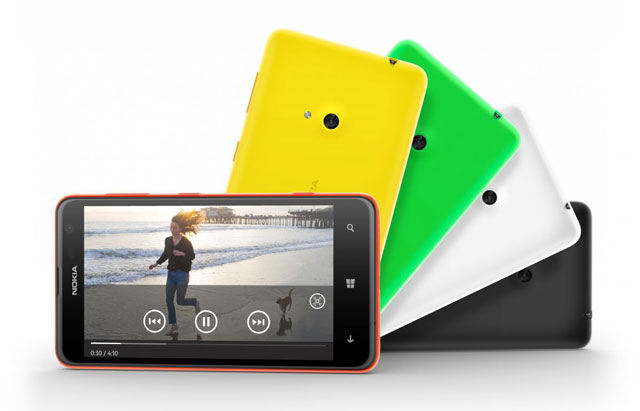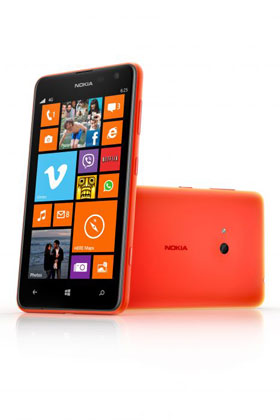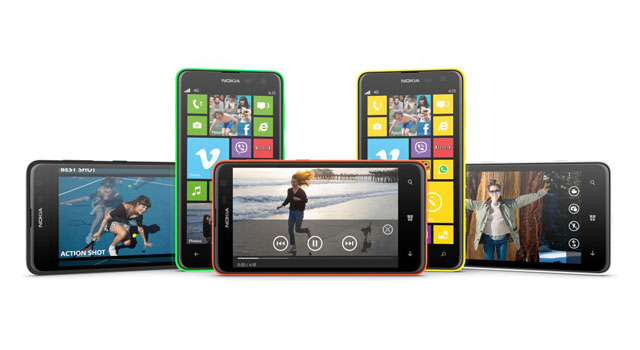
The top end of the smartphone market is well served with Lumia devices and the bottom end has the sub-R2 000 Lumia 520. But the midrange hasn’t had an update since 2012’s 620. Enter the Lumia 625, which, despite its similar name, is a wholly different device.
Two things in particular set the 625 apart from its predecessor: the size of its screen — at 4,7-inches it’s the largest screen Nokia has put on a device to date — and its support for three 4G/LTE bands at 800MHz, 1,8GHz and 2,6GHz.
The question is, do consumers in the market for a R3 499 smartphone really care enough about 4G for that to influence their purchasing decision? In the case of South Africans, we suspect the answer is “no”.
In that case, we’d best look at what else the Lumia 625 has to offer. The next obvious port of call is the display. One of the things we’ve come to love about the Lumia range is the way the Gorilla Glass displays are gently curved, meniscus-like, at the edges. The 625 continues this trend.
Though its dimensions are substantial, the same can’t be said of the display’s resolution. At just 480×800 pixels, which results in a pedestrian pixel density of around 199ppi, the 625’s display is big, but it’s not beautiful.
 Mind you, the display on the 625 isn’t dreadful. And it’s great that Nokia’s included it’s “super sensitivity” setting that allows you to use it with gloves. But it’s poor when compared to other, admittedly more expensive devices with 4,7-inch displays. A smaller display would make the WVGA resolution less noticeable.
Mind you, the display on the 625 isn’t dreadful. And it’s great that Nokia’s included it’s “super sensitivity” setting that allows you to use it with gloves. But it’s poor when compared to other, admittedly more expensive devices with 4,7-inch displays. A smaller display would make the WVGA resolution less noticeable.
Still, there’s an upside to Nokia’s decision to go large — to the casual observer, the 625 looks like a far fancier and pricier device than it is. Also, there is no doubt a market for larger displays on cheaper devices, particularly for those looking to watch video on their device without forking out top-end smartphone prices and for people for whom their phone is their only way of getting online.
Also, given the low resolution of the display, the 2 000mAh battery will last at least a full day, even with heavy use.
The 625 fits the midrange mould perfectly: 1,2GHz dual-core processor, 512MB of RAM, 8GB of memory, a 5-megapixel rear-facing camera, VGA front-facing camera and an FM radio receiver. This is all wrapped up in brightly coloured polycarbonate covers.
Although the rear cover of the 625 is removable — harking back to the Nokia 5100 of 1998 and the countless “customisable” handsets that followed it — the battery is not.
Solid and well made
The cover on our review unit was a vivid green, but Nokia also makes them in white, black, yellow and orange. The covers are matte rather than glossy, and the rounded edges, along with the rounded corners that help define the Lumia range, make for a phone that feels great in the hand. At 159g, the 625 feels like a solid, well-made smartphone.
Remove the rear cover and there’s a slot for the micro Sim stacked on top of a slot for a microSD card (the 625 supports cards up to 64GB). The right-hand side of the phone is home to a dedicated camera button (a great inclusion), the power/lock button and a volume rocker. The power/lock button is positioned two-thirds of the way up the side of the device, perfectly placed for use with your thumb, if right handed, or your index finger, if left-handed.
Although the buttons are all built into the rear cover, they feel sturdy and responsive, and the two steps of the camera button — half-press to focus and full-press to capture — can each be felt distinctly. This is a fantastic design decision because it makes the 625 feel like a real camera.
Though the primary camera is only five megapixels, it produces vibrant stills and is capable of capturing 1080p video at 30 frames per second. It’s also got a fairly speedy f2,4 aperture. If you’d rather not use the dedicated shutter release button, tapping anywhere on the screen in camera mode will focus on that point and take an image once focus is achieved.

Nokia has also included its Smart Cam feature on the 625, which takes a series of photos in quick succession and then offers users the ability to select the best shot, create an action sequence from them, remove moving objects in the series, or pick the best facial expression. The megapixel count may not sound impressive, but the functionality the 625 offers for images via software are excellent and unusual on such an affordable phone.
The bottom of the 625 houses the micro USB port used for charging and data transfer, while the top is home to the 3,5mm audio jack. Beyond those, the only other interruptions to the cover are the holes for the camera lens and LCD flash and the speaker.
Missing apps
On the software front, the 625 suffers the same problem as every other Windows Phone handset: a lack of several key apps, including Instagram.
Nevertheless, Windows Phone looks better with every update and really does look increasingly like the strongest contender for third position in the battle of the mobile operating systems.
At R3 499, the 625 is a well-equipped handset at a reasonable price. But perhaps Nokia should have ditched the 4G/LTE antenna in favour of an even lower price. In this market, it seems like a differentiator that won’t woo its target market. — (c) 2013 NewsCentral Media




